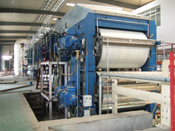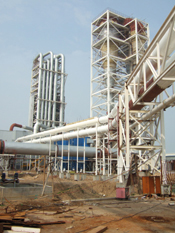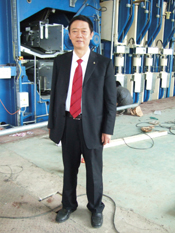A panel warrior
17 June 2009ShaanXi Zhong Xing Timber Co Ltd is a privately-owned business with four MDF lines, a 15-year history in the business and some interesting plans for the future. Mike Botting visited its latest line near the world-famous city of Xian
If you are wondering why the name Xian City is familiar, it is probably because it is the home of the Terracotta Warrior Army, arguably one of the world’s greatest historic treasures.
If you are a regular reader of WBPI, as I hope you are, then it may also be familiar because you remember the article about ShaanXi Zhong Xing Timber Co Ltd in the August/September 2006
edition (p45)!
Owned by a gentleman called Mr Liu Zhongxin, chairman of the company, ShaanXi Zhong Xing has two multi-opening MDF lines in Hanzhong City, 400km from Xian. Today it also has two continuous lines imported from Europe.
The first multi-opening line was built in 1995 and employed a 12-daylight hot press supplied by Sichuan Donghua Machinery Co Ltd. It has a nominal capacity of 30,000m3 a year. I asked Mr Liu what drew him into manufacturing MDF at that time.
“In China there are not so many forests and you need forest to produce solid wooden furniture,he pointed out. “I have heard that China is only number 120 worldwide in terms of forest cover which means there is very little wood per capita of population. But with a population of 1.3 billion people and everybody needing furniture and beds, in the past we had to use solid wood.”
Up to the time he built his first MDF line, Mr Liu worked for over 20 years in the solid wood furniture manufacturing industry in a company which imported the wood, so he was ideally placed to see the potential for MDF.
“The quality of some of the imported solid wood was not good and it moved and cracked, so I thought MDF would be a better idea for furniture manufacture,said Mr Liu. “That was one reason I chose MDF. Another was that the market in China was so large and the government was offering strong support to the MDF industry, including the duty-free import of machinery for the MDF factory.
“At first we could sell everything we could produce – and get the money ‘up front’ from the customers.
“Starting in 1998, the government supported farmers in growing trees and encouraged them to sell the small diameter wood such as branches to MDF manufacturers, which also helped us.”
Mr Liu started production on his second multi-opening line in 2000. This time the line came from a different Chinese manufacturer – Shanghai Wood Based Panel Machinery Co Ltd. In 2001, his company planted 360,000mu (24,000ha) of trees to provide raw material for his factories.
ShaanXi Zhong Xing’s first continuous MDF production line started up in 2005 with an annual design capacity of 150,000m3 but today can produce 200,000m3 a year (WBPI issue 4, 2006, p45). The Dieffenbacher CPS press is 23.2m long and eight feet wide. Dryer to finishing line was supplied as part of the press package, while the refining system came from Pallmann of Germany and is a 54in unit. Steinemann supplied the six-head sander and Anthon the saw system.
The second continuous MDF line (often known as Xian ll) was also supplied by Dieffenbacher from dryer to finishing line, with a CPS press of 23.6m long and eight feet wide. The company aims to mainly produce 3mm thick board on this line and anticipates an annual output capacity of 220,000m3.
The decision was effectively made at Ligna 2007, following meetings with the main continuous press suppliers of the day: Siempelkamp, Dieffenbacher and Metso. The contract with Dieffenbacher was signed that August.
This second continuous line is located about 80km from the first continuous line and 100km from the centre of Xian City, in Jinghe Industrial Zone. Groundworks for the line began in July 2008 and the buildings were completed in January 2009. The first board came off the line on Wednesday 6th May – two weeks after my visit.
This time the refiner came from Andritz and is a 54in unit. Anthon again supplied the cut-to-size system and Steinemann the sander, though this time it is an eight-head machine. GreCon supplied the quality control equipment. Chipping, the energy plant and the resin manufacturing plant were all made by Chinese companies.
The wood supply for both the ShaanXi continuous lines is rather unusual. This area of China is famous throughout the country for its apples and it is apple wood that supplies all the raw material for the two lines.
“There is no competition for our apple wood supply as we are the only MDF manufacturer in this area and we utilise the old trunks of trees which are being replaced and the branches of those that are pruned. There are nearly eight million mu (0.53m ha) of apple orchards around here, so there is plenty of wood supply and the government continues to encourage the planting of apple trees,said Mr Liu, suggesting that Shaanxi province has 40% of the worldwide apple market. “Also in this area there is a rich supply of oil, gas and coal so trees are not burned as fuel.”
At the end of this year, Mr Liu intends to launch his company on the Chinese stock market, with the encouragement of the government apparently, and thus to raise cash to invest in the business.
However, he does not intend to build any more MDF/HDF capacity. He considers that there is enough to balance demand in China now – an increasingly commonly-held belief in the Chinese industry.
Instead, Mr Liu wants to build not one, but two, OSB lines with a total capacity of 600,000m3.
The basis of the presentation to the stock market will be to build the two OSB lines in 2011 or at the latest, 2012, confirmed Mr Liu. “In the past we have had to expand slowly because we could only raise money from the bank, but once we are quoted on the stock exchange, we can expand more quickly.”
However, apple trees are not the intended fibre source this time.
“In this area there are also 20 million mu of pine trees which were seeded by aeroplane 30 years ago,said Mr Liu. “Because of the aerial seeding, they are growing far too close together and need to be thinned out, so the local government is encouraging me to use these thinnings which will mean three good things: The farmers will get an income; we will get the raw material [for OSB]; and the forest will be improved and protected.
“Since the earthquake in Sichuan Province on May 12, 2008, the government has encouraged the use of OSB in housebuilding. One hundred thousand people died in that earthquake and the government sees wooden buildings as faster and more flexible replacements.”
I asked Mr Liu if he now regretted the timing of his second continuous MDF line in light of the global economic situation.
He replied that his company had sold all it produced in the first quarter of 2009, although the price was very low, having fallen by an average of about RMB460 (US$68) per m3 and a maximum of RMB700/m3 from highs of RMB2,200/m3.
“The MDF capacity in the China market is about 30 million m3,said Mr Liu. “Around 30% of that was exported and now that capacity is back on the domestic market and everybody has had to reduce prices to maintain capacity.
“Maybe for the next two years there will be big competition on the panel market and manufacturers must supply good quality and reduce their costs. I expect some economic recovery in September this year, but I am also prepared for it to take two or three years. But that is for panels to be used on the interior market. If we build OSB capacity it will be for a new market for outdoor construction. I do not believe it will be difficult to introduce wooden housing to people.”
Mr Liu has already had meetings with a Chinese supplier of imported OSB who is interested in an exclusive distribution arrangement – and in buying shares in Mr Liu’s company.
As for the existing facilities, there is space on the latest MDF mill site for further development and Mr Liu is looking at various options, including some form of value-adding, though no decision has yet been made.


